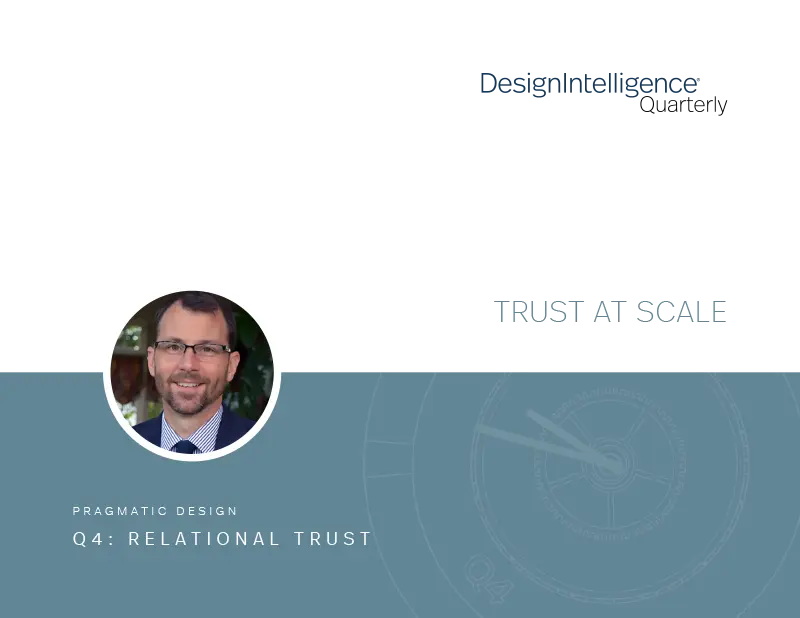Trust at Scale
by Bob Fisher
Principal with DI Advisory
December 13, 2023
Building the Right Relationship with the Market
Some concepts are so essential to being human, so deeply engrained in our daily lives, they become invisible. We use these ideas frequently, yet unconsciously, and we rarely question what we know about them. Two prime examples are trust and relationship.
The American Psychological Association (APA) says that trust is “confidence that a person or group of people has in the reliability of another person or group; specifically, it is the degree to which each party feels that they can depend on the other party to do what they say they will do.” They also describe trust as a primary component in mature relationships.
It is natural to think about trust and relationships in a personal context. From childhood, we learned to understand how to establish and manage our connections with others. We gained understanding through trial and error in our interactions with family, friends, classmates, teachers, coaches and others. Along the way, we evaluated people and situations based on our sense of trust. We also learned the importance of being trustworthy and how to let others earn our trust. These experiences shaped our intuition. In most cases, the intuitive, person-to-person approach serves us well.
However, in positions of leadership, we need to think about trust and relationships on larger scales. Not only must we create a culture in our firms that fosters trust bonds among members, we should also consider how trust and relationships can be built between our firms and the market.
Few would disagree that the ideas of trust and relationship are important in marketing and business development. Obviously, people will not do business with organizations they mistrust, just as they avoid dealing with individuals they find untrustworthy. Yet, the question remains: How do firms go about establishing relational trust with their target markets?
In many cases, firms use an approach based on the intuitive, person-to-person model. They strive to serve their clients honestly and effectively, thinking this alone will help build trust. The goal is to make clients happy and, in doing so, earn a good reputation.
That’s not wrong, but it’s only part of what needs to be done. To build relational trust with a market, we need to begin by thinking at the right scale.

Individual vs. Group Trust
When a firm aims to establish trust in the market, it’s essentially working to shape the collective opinions about itself among a multitude of individuals.
But trust in large group settings, like firms and their markets, differs from trust between individuals. These group dynamics are more intricate and less personal. The timeframes and responsibilities involved, along with the levels of risk, uncertainty and accountability, are notably different.
Timeframe
It’s difficult for firms to become fast friends with the market. Creating trust at the collective level requires the word to spread and build gradually.
Responsibilities
Firm reputation is shaped by the actions and attitudes of almost everyone within it. Whether they are involved in business development, design, technical roles, support functions or any other capacity, both leaders and employees create impressions on others. The way they interact with clients, delivery partners, vendors, peer firms and others collectively molds the reputation of the firm.
Risk and Uncertainty
An organization’s reputation is not merely in the hands of its leaders and employees. It exists within a broader ecosystem, and it can be influenced by external events or the actions of others. Perceptions — even incorrect ones — are reality.
Accountability
Holding an individual accountable is relatively straightforward. When dealing with an organization, accountability becomes more complex. It involves multiple stakeholders, hierarchical structures and shared responsibility.

Creating Collective Belief
A small but powerful subset of the collective beliefs about a firm is formed through the direct experiences of those who have personally interacted with it. These individuals often share their opinions, whether positive or negative, with others who may pass along a version of what they’ve heard.
Word-of-mouth and other forms of testimonials, shared in person or online, can contribute to what psychologists refer to as “social proof” or “informational social influence.” The concept describes how individuals, when uncertain, tend to rely on others to shape their opinions. A similar principle likely applies to media relations. When a news or industry media outlet features a firm in a positive story, it carries an implicit third-party endorsement, which provides credibility. In short, stories about a firm are more powerful when told by someone who doesn’t work there.1
In my work with firms, I’ve noticed few of them intentionally prioritize social proof. Most don’t consciously work on fostering word-of-mouth referrals or consistently gathering testimonials. Few invest properly in media relations (which could be the subject of its own article).
A firm cannot always have someone else speak on its behalf. It needs to be able to share its own story to shape how people see it. Building trust in your firm through marketing is a challenge because potential buyers tend to be skeptical. Telling them you’re trustworthy doesn’t work. Instead, demonstrate it. One effective way is to tell stories about the success you helped others achieve — in terms that matter most to your audience.
Another way is to show them.
Trust in Business
For the past 23 years, global public relations firm Edelman has published a survey-based study called the Trust Barometer. This year, it asked 32,000+ respondents in 28 countries about trust in various institutions, such as government, NGOs, business and the media.
Of the institutions measured, respondents felt that business was the most trustworthy. In 26 countries, respondents reported a 12% difference in their trust of business over government. Respondents in 23 countries felt that business was the only institution that was both trustworthy and competent.3
Inside-Out
Those who work in professional service firms play the most important role in shaping their brands. While the quality of the work is significant, if the design and construction process becomes too challenging for clients, they may not choose the firm again. The way the firm markets itself also matters, but only if it accurately reflects the actual client experience as discussed below. Employees play a crucial role because their actions and attitudes shape the brand experience.
The process of winning, designing and delivering projects involves many client interactions. No manual can provide all the answers for every situation employees encounter. They must rely on good judgment in their interactions and truly understand and embody the values and principles of the firm they work for.
Culture can be seen as the set of unwritten (and unspoken) rules that govern the behavior of people in the organization. They learn it by inference. People say and do what they sense is right based on the context they observe, and they follow the tone and example set by leaders.
Establishing trust with the market starts with the firm’s culture. Acting in a trustworthy manner, which means consistently doing what you say you will do, should be a fundamental value within the firm. Leaders must actively endorse and demonstrate this value. They should also ensure that everyone in the firm adheres to the same standard and is held accountable for it.
The Integrity Gap
As the APA definition shows, trust is about dependability relative to expectations. The way a firm presents itself through its marketing communications is like making a promise. If the market gets less than what it was led to expect, an “integrity gap” opens. This gap can harm firms because the market is likely to draw one of two negative conclusions: Either the firm lacked the competence to fulfill its promises, or it was dishonest. Neither of those perceptions is the basis for a desirable reputation.
The integrity gap usually isn’t something people create on purpose. It often happens when a firm tries too hard to stand out by making big promises, akin to inflating a resume. Or it can occur when the firm portrays itself as it dreams of being, even if it’s not quite there yet. Honesty keeps the gap closed.
Trust’s Power and Fragility
As shown in a well-known study led by Dr. John Gottman and Robert Levenson, a stable relationship typically needs a ratio of about five positive interactions for every one negative interaction to thrive. In simpler terms, for every negative interaction, there should be at least five positive ones.2
Developing trust with the market takes time. It must be cultivated through intentional, consistent effort. It results from a series of promises made and kept — including promises made through the firm’s communication with the market.
Challenges to trust are bound to happen in regular client relationships. It’s wise to get ready for them by building a strong foundation of goodwill through honest words and actions that prioritize everyone’s best interests. When a mistake occurs, it doesn’t have to be a catastrophe. Effective recovery from such situations can boost trust in the long run because it offers a chance to demonstrate the firm’s true character and, having overcome the hurdle together, can actually strengthen the mutual bond between firm and client.
Bob Fisher is a principal with DI Advisory and a frequent contributor to DI Quarterly.
FOOTNOTES:
1 Naveen Amblee & Tung Bui , “Harnessing the Influence of Social Proof in Online Shopping: The Effect of Electronic Word of Mouth on Sales of Digital Microproducts,” International Journal of Electronic Commerce, 16, vol. 2 (2011): 91-114, DOI: 10.2753/JEC1086-4415160205.
2 Kyle Benson, “The Magic Relationship Ratio, According to Science,” The Gottman Institute, https://www.gottman.com/blog/the-magic-relationship-ratio-according-science/. Accessed October 5, 2023.
3 APA Dictionary of Psychology. (n.d.). https://dictionary.apa.org/trust


